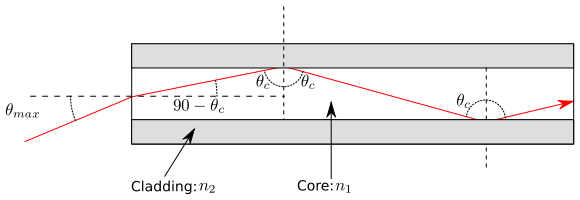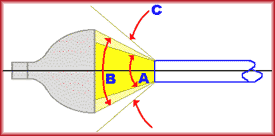Definition of Numerical Aperture for BTech 1st Year Physics:
sine of the maximum angle of an incident beam of some optical device, or the sine of the acceptance angle of a wave guide or fiber.

The numerical aperture (NA) of the fiber is the sine of the maximum angle of an incident ray with respect to the fiber axis, so that the transmitted beam is guided in the core. The NA is determined by the refractive index difference between core and cladding, more precisely by the relation:

which can be derived from the requirement that the transmitted beam at the core/cladding interface propagates with the critical angle for total internal reflection. Here, n0 is the refractive index of the medium around the fiber, which is close to 1 in case of air.
Calculation of Numerical Aperture:

- Angle A (29 degrees) is the acceptance angle of a N.A. .25 fiber.
- Angle B (45 degrees) is the incident angle from the bulb.
- Angle C (83 degrees) is the acceptance angle of a N.A. .66 fiber.
Calculating the N.A. for the 45 degree angle (B) of incidence yields .38 (sin(45/2)). Therefore, fiber with an N.A. of .66 will accept all of the light from the bulb, but the output cone at the other end will be 45 degrees, not the 83 degrees that you might expect. Conversely, the N.A. .25 fiber is not capable of accepting all the light from the bulb. Any light transmitted through this fiber will create an output cone of 29 degrees.

Point to point perfect information, useful